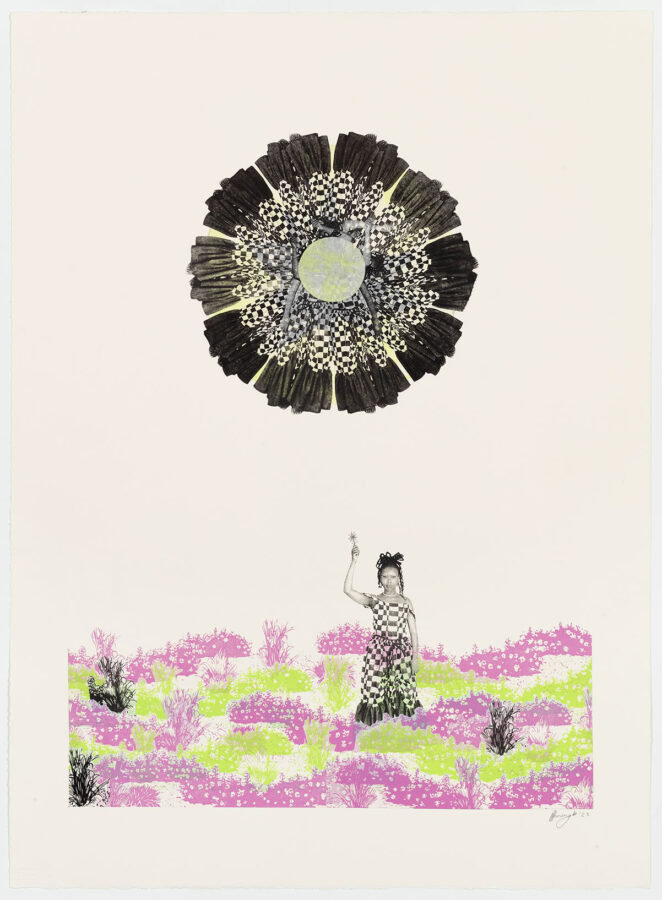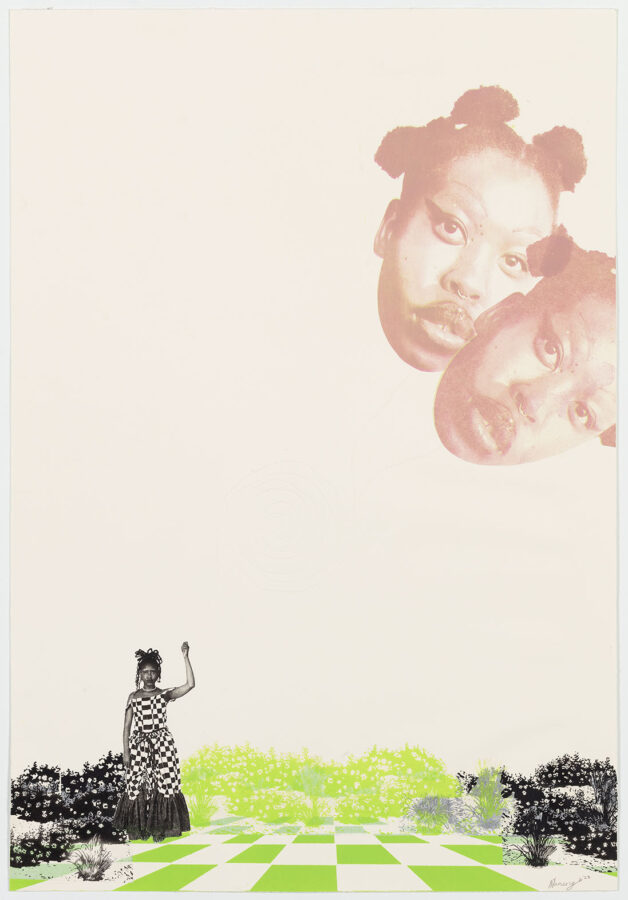Natalie Paneng’s solo exhibition, Uncanny Valley, opened in June 2024 in the checker board room at The Blue House gallery.
Uncanny Valley expands her practice into hand-printed fine artworks, while seamlessly blending digital projection, immersive soundscapes, and experimental sculptural works.

Written by Danijela Cook
Natalie Paneng’s interest in the Uncanny Valley lies in its potential to raise eerie, suspecting sensations; where worlds are blended and limitless. The term Uncanny Vallery was coined by roboticist, Masahito Mori in the 1970s, to describe the discomfort that arises the interaction with things that are recognisably human but undoubtably, a little bit off.
For Paneng, an artist who primarily works in the digital space, it seems natural to be curious about the interim of processing digital information and the ‘real’ – this curiosity has led her to lean into the theme of uncanniness as a prompt to create dreamscapes where the context and the ‘happening’ blend into surrealist loops. The artist motivates her intentions of place-making by creating, “[a space] where the thread of connection and memory is present but the are many levels of blurred accuracy and more than one gravitational force at play.”


Through these images, Paneng has created dreamscapes in which all energy is suspended. There is a light tension between the figures and their context; the characters seemingly floating through the artist’s checkerboard playground.
Although brought to life through Paneng’s presence and performance, her characters are primarily fictional vessels that express a confident imagination, encouraging viewers to indulge in fairy-like feelings of whimsy and naivety. She returns to the freedom of the inner child through her world building, intending to share this energy with the viewer while also using her process as a reflective act on self-navigation.
In her exploration of the Uncanny Valley, the artist has also crafted a unique blend of digital and traditional/tangible mediums. In doing so, creating a new sense of the uncanny by integrating digital aspects into her unique printed works; by using pronto lithography and leveraging the graphic quality of linocut, she has removed an element of the handmade quality typically associated with printmaking. Simultaneously, the precision and control inherent in digital making is also diminished. This results in artworks that reside in the valley between the digital and the real, evoking the suspicious effect originally described by Mori.




The duplication of figures and iterative compositions enhance the sense of the uncanny. With heads floating like balloons and figures mimicking the hands of a clock, each new position drives the figures further away from their human essence. This inaccuracy connects the works to surrealist dreamscapes, where each element challenges the reliability of our consciousness.

“In a time where abundance has been made the standard, Natalie’s works are isolated dreamscapes that make use of only 3 colours green, pink and black. This decision creates a sense of openness in an otherwise overloaded system/environment. With each piece Natalie takes us through a journey of self-perception similar to that of Alice. In Wonderland, Alice’s shape, size, environment and perception of time is ever-changing, thus her notion of self is constantly in question and as a result self-awareness is brought to being by overloading her, much like when a vivid dream turns lucid and suddenly, you’re awake” – Sbongiseni Khulu

In a world often ruled by angst and mundanity, it seems near revolutionary to decide to exist in a self-made world motivated by imagination and joy, and even more so to invite others to wander in. In Paneng’s world, joy and uncanniness coexist, offering a space where imagination reigns supreme and the mundane is transformed into something dreamy. By inviting us into her fantastical realms, she allows an experience of her magic and to look at the world through a lens of wonder.

Natalie Paneng, a multi-disciplinary artist, identifies as a world-builder, using her practice to explore and share imagined and alternative realities through various mediums. Combining her self-taught digital skills with her theatre background, she creates vibrant works that hold a clear and unique point of view.
Paneng connected with our operations after being selected for a residency with the Leipzig International Art Programme (LIA), associated with The Centre for the Less Good Idea. This residency, aimed at South African digital media artists, involved a collaborative printmaking project in Leipzig, Germany. David Krut Projects helped with the selection process and provided initial printmaking exposure to the artists before their overseas residencies. In 2022 David Krut Workshop (DKW) invited Paneng to collaborate on a series of prints with Sbongiseni Khulu, a process that has spanned continents over the following months and yielded a vibrant body of work unlike anything else in our archive.
Her print works, made in collaboration with DKW printmaker Sbongiseni Khulu, are distinguished by their punchy and playful use of pink and bright green. After starting with the monotype process, Paneng expressed interest in linocut for its graphic quality as well as pronto lithography to incorporate her character into her work. The body of work progressed into a series of whimsical scenes set in Paneng’s checkerboard playground, combing the printmaking processes of linocut, pronto lithography and embossing.